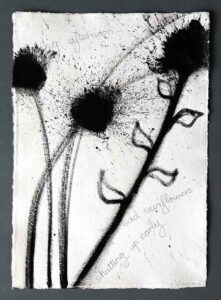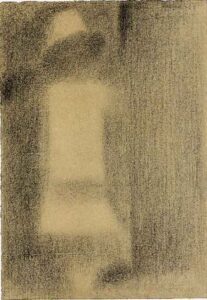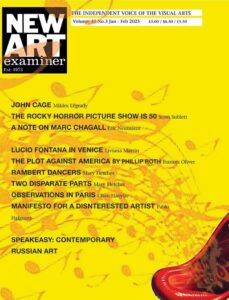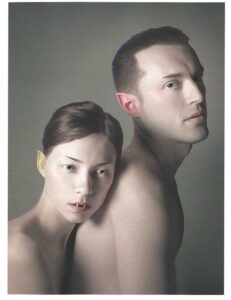
Anthony Viney

If you have ever printed from a black-and-white film negative, you will have experienced seeing a photographic image gradually appear on white paper and, if left in the chemical bath long enough, disappear into darkness. To see something appear out of nothing and evolve towards nothing is to experience transience.
Feelings of transience are a significant presence in the work of some 19th and 20th–century European artists, especially in their drawings and etchings. For example, the black-and-white drawings of Georges Seurat or the etchings of Samuel Palmer. The interplay of light and dark, shadow and highlight can, on longer contemplation, become the main subject of their work. Palmer wrote: “It seems to me the charm of etching is the glimmering through of the white paper even in the shadows so that almost everything sparkles or suggests sparkles.” And Seurat observed: “The means of expression is the optical mixture of tones … of the lights and of their reactions (shadows) following the laws of contrast, of gradation, of irradiation.”
Both artists lived at a time when Japan was opening up to the west, and when its radically different sense of art and philosophy was influencing European artists. One of the key concepts in traditional Japanese culture is transience, with its powerful imperative to celebrate and enjoy the moment (the cherry blossom festival is the obvious example). In the West, the traditional response to the reality of human transience, while less positive, is nonetheless an important theme. Consider, for example, the concept of et in Arcadia ego (I am even in Arcadia) in European art (which suggests that even in the most beautiful of places, death is still found). On the whole, classical European culture was much closer to eastern beliefs than to those of Christendom. “Nothing retains its form; new shapes from old,” wrote Ovid. “Nature, the great inventor, ceaselessly contrives. In all creation, be assured, there is no death – no death, but only change and innovation; what we men call birth is but a different new beginning; death is but to cease to be the same. Perhaps this may have moved to that, and that to this, yet still the sum of things remains the same.”
While not lightening the European mood completely, the Japanese sense of the human condition did perhaps start to engage and challenge some of the West’s more exclusively melancholic attitudes to death. And these beliefs gradually filtered through into the work of contemporary artists who had a natural affinity with transient moods and atmospheres.

What Seurat called ‘irradiation’, that delicate nuance of light and shadow, is beautifully captured in his finest drawings. Sometimes he dissolves the form of the subject (e.g. Child in White), at other times forms disappear into shadow. But there is always the sense of things evolving out of something or dissolving into something. The mood can be joyful or darker depending on the artist’s approach – but he was very well aware of what he was doing. He wrote: “Gaiety of tone is the luminous dominant, of tint, the warm dominant, of line, lines above the horizontal. Calmness of tone is the equality of dark and light; of tint, of warm and cool, and the horizontal for line. Sadness of tone is the dark dominant; of tint, the cool dominant, and of line, downward directions.”
Seurat’s drawing The Gateway has a frozen ‘out of time’ sense that encourages us to linger and consider the fleeting moment. It feels rather like a photograph, in that it captures a brief moment, but at the same time it is unlike a photograph because it’s a drawing that took quite a long time to create. Sensing, simultaneously, two different passages of time gives us space to contemplate, while also experiencing the fleeting moment with its sense of impermanence. Seurat drawings are often complete works in their own right, rather than just compositions and sketches for his wonderful paintings. And it’s the mood in those drawings, that, for me, comes closest to capturing transience.
The etchings of Samuel Palmer are, likewise, imbued with a sense of transience – albeit of a very English, pastoral kind. Take The Herdsman’s Cottage, in which the rays of the late sun illuminate the cottage and the dark woods. The energy and atmosphere expressed here are not those of sadness but of transformation and hope. To look into Palmer’s small etchings is to experience uplifting feelings, although the artist never allows us to forget for one moment the fundamental evanescence of his shadowy works. As he writes: “When less than four years old I was standing with my nurse, Mary Ward, watching the shadows on the wall from branches of an elm behind which the moon had risen. She transferred and fixed the fleeting image in my memory by repeating the couplet, ‘Vain man, the vision of a moment made, Dream of a dream and shadow of a shade.’ I have never forgot those shadows and am often trying to paint them.”
Another kindred spirit among western artists is Giorgio Morandi. While on first sight his etchings and drawings may seem very different to those of Seurat and Palmer, the moods and atmospheres of transience are nonetheless pronounced. His drawings from the 1960s appear to dissolve his still-life objects – those treasured artefacts he’d been painting for most of his life – into a network of negative spaces that hover between the jugs and bowls. Faint suggestions of shadows, and the dissolving movements of his line into the whiteness of the paper become the main focus of these late works. The sense of transience is captured precisely, but once again there is little feeling of melancholy here and instead a sense of an artist striving towards something and completely aware of what he was trying to achieve. As Franz Armin Morat has observed, the point of these drawings “… is of course not to recognise the objects, but to experience through contemplation the antagonism between dissolution and reconstitution”.

What do all the works mentioned above have in common? They are created in black and white and are drawn or printed on paper. And, as with black-and-white photographs, is there something about the absence of colour that creates space for feelings of impermanence to take hold? I’d like to suggest that black and white in particular allows the viewer enough emotional distance for contemplation and the feelings associated with the passing of time.
And while paper can survive for centuries, the knowledge that it can be easily destroyed gives it an ephemeral quality. This makes it a good medium for conveying impermanence and may help explain why, more than canvas or wooden panels, it supports the expression of feeling that everything must pass.
Of 20th–century European, and especially American, painters whose works can be seen as a celebration of transience, Mark Rothko and Sam Francis are just two who come to mind. And in the sphere of photography, the quiet works of Paul Caponigro celebrate the magic of impermanence. His Woods, Redding, Connecticut photographs first caught my eye while I was at art school, and made me want to understand better what his work is really about. Caponigro wrote: “At the root of creativity is an impulse to understand, to make sense of random and often unrelated details. For me, photography provides an intersection of time, space, light, and emotional stance. One needs to be still enough, observant enough, and aware enough to recognise the life of the materials, to be able to ‘hear through the eyes’.”
The dialogue between west and east remains an important way for contemporary western artists to discover a wealth of alternative responses to mortality. Indeed my own experiences and artistic practice parallel those of some of the artists mentioned above. Over the last year I’ve been working on a series of black-and-white paintings in gouache produced on handmade paper. They are a response to the increased sense of mortality I (and so many others) have been feeling in these times. But they are also about the energy of the creative process and the desire to allow something new to come into existence. These works often include a haiku – the play between the words and image giving the clearest expression of the energy and transient mood I’m seeking. It has taken me a long time to recognise the quality of evanescence in my work and find the simplest way to express it, but, looking back, I can see that the paintings and drawings that work the best are those that have a strong sense of transience about them. And I freely acknowledge my debt to the many artists who have explored this territory before me.
Volume 35 no 3 January – February 2021

